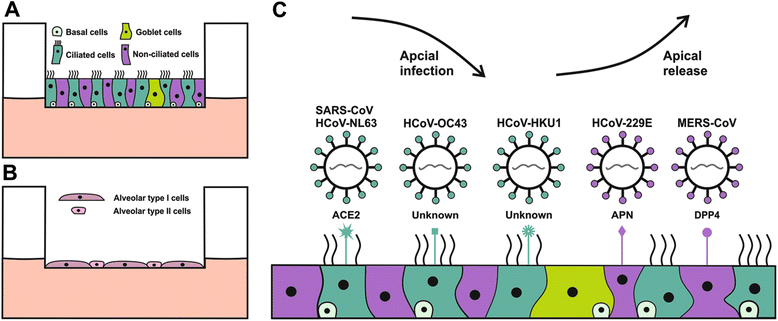Coronaviruses and the human airway: a universal system for virus-host interaction studies
- PMID: 26852031
- PMCID: PMC4744394
- DOI: 10.1186/s12985-016-0479-5
Coronaviruses and the human airway: a universal system for virus-host interaction studies
Abstract
Human coronaviruses (HCoVs) are large RNA viruses that infect the human respiratory tract. The emergence of both Severe Acute Respiratory Syndrome and Middle East Respiratory syndrome CoVs as well as the yearly circulation of four common CoVs highlights the importance of elucidating the different mechanisms employed by these viruses to evade the host immune response, determine their tropism and identify antiviral compounds. Various animal models have been established to investigate HCoV infection, including mice and non-human primates. To establish a link between the research conducted in animal models and humans, an organotypic human airway culture system, that recapitulates the human airway epithelium, has been developed. Currently, different cell culture systems are available to recapitulate the human airways, including the Air-Liquid Interface (ALI) human airway epithelium (HAE) model. Tracheobronchial HAE cultures recapitulate the primary entry point of human respiratory viruses while the alveolar model allows for elucidation of mechanisms involved in viral infection and pathogenesis in the alveoli. These organotypic human airway cultures represent a universal platform to study respiratory virus-host interaction by offering more detailed insights compared to cell lines. Additionally, the epidemic potential of this virus family highlights the need for both vaccines and antivirals. No commercial vaccine is available but various effective antivirals have been identified, some with potential for human treatment. These morphological airway cultures are also well suited for the identification of antivirals, evaluation of compound toxicity and viral inhibition.
Figures

Similar articles
-
Isolation and characterization of current human coronavirus strains in primary human epithelial cell cultures reveal differences in target cell tropism.J Virol. 2013 Jun;87(11):6081-90. doi: 10.1128/JVI.03368-12. Epub 2013 Feb 20. J Virol. 2013. PMID: 23427150 Free PMC article.
-
Tropism of and innate immune responses to the novel human betacoronavirus lineage C virus in human ex vivo respiratory organ cultures.J Virol. 2013 Jun;87(12):6604-14. doi: 10.1128/JVI.00009-13. Epub 2013 Apr 3. J Virol. 2013. PMID: 23552422 Free PMC article.
-
Membrane ectopeptidases targeted by human coronaviruses.Curr Opin Virol. 2014 Jun;6:55-60. doi: 10.1016/j.coviro.2014.03.011. Epub 2014 Apr 22. Curr Opin Virol. 2014. PMID: 24762977 Free PMC article. Review.
-
Efficient replication of the novel human betacoronavirus EMC on primary human epithelium highlights its zoonotic potential.mBio. 2013 Feb 19;4(1):e00611-12. doi: 10.1128/mBio.00611-12. mBio. 2013. PMID: 23422412 Free PMC article.
-
Modeling pathogenesis of emergent and pre-emergent human coronaviruses in mice.Mamm Genome. 2018 Aug;29(7-8):367-383. doi: 10.1007/s00335-018-9760-9. Epub 2018 Jul 24. Mamm Genome. 2018. PMID: 30043100 Free PMC article. Review.
Cited by
-
Preparedness needs research: How fundamental science and international collaboration accelerated the response to COVID-19.PLoS Pathog. 2020 Oct 9;16(10):e1008902. doi: 10.1371/journal.ppat.1008902. eCollection 2020 Oct. PLoS Pathog. 2020. PMID: 33035262 Free PMC article. Review.
-
Translational PK/PD for the Development of Novel Antibiotics-A Drug Developer's Perspective.Antibiotics (Basel). 2024 Jan 11;13(1):72. doi: 10.3390/antibiotics13010072. Antibiotics (Basel). 2024. PMID: 38247631 Free PMC article. Review.
-
Solar simulated ultraviolet radiation inactivates HCoV-NL63 and SARS-CoV-2 coronaviruses at environmentally relevant doses.J Photochem Photobiol B. 2021 Nov;224:112319. doi: 10.1016/j.jphotobiol.2021.112319. Epub 2021 Sep 21. J Photochem Photobiol B. 2021. PMID: 34598020 Free PMC article.
-
Differential interferon-α subtype induced immune signatures are associated with suppression of SARS-CoV-2 infection.Proc Natl Acad Sci U S A. 2022 Feb 22;119(8):e2111600119. doi: 10.1073/pnas.2111600119. Proc Natl Acad Sci U S A. 2022. PMID: 35131898 Free PMC article.
-
Live imaging of airway epithelium reveals that mucociliary clearance modulates SARS-CoV-2 spread.Nat Commun. 2024 Nov 2;15(1):9480. doi: 10.1038/s41467-024-53791-4. Nat Commun. 2024. PMID: 39488529 Free PMC article.
References
Publication types
MeSH terms
Substances
LinkOut - more resources
Full Text Sources
Other Literature Sources

